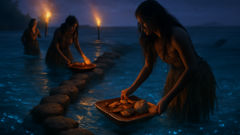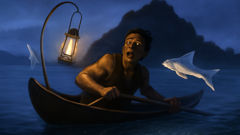Introduction
They tell the story of the Adaro in low voices beneath coconut palms and inside the thatched cool of houses where the salt smell lingers in the rafters. It is a name spoken to steady the nets, to warn the children who run too close to the reef at dusk, and to explain the craft lost beneath a sudden swell. The Adaro is not a simple monster to be slain; it is a presence of the deep, a creature pulled from the brininess of reef and whirlpool, a being shaped like fish and man and seaweed, whose teeth glitter like broken mother-of-pearl. In the wide horizon between lagoon and ocean, between lagoon safety and the open water's hunger, the Adaro keeps its erratic watch. Old women add chalk marks to paddles and men tie shells to their belts; there are songs and offerings, and the children learn the sound of the sea that means caution. The core of the tale holds a lesson: the ocean answers when the boundary is ignored. In many villages the Adaro is blamed for sudden sicknesses that begin with a sting, a rash, then fever. They say the spirit can fling poisonous fish from the water as if they were stones, small living darts that find flesh and set poison like a thorn. Those struck either die quickly or endure long, slow wasting. This legend, like the currents that shape the shoals, knits together cautionary wisdom and memory of storms, of nets ripped and canoes sunk. What follows is not only a retelling of a creature that walks and swims in the same breath; it is a portrait of a people living in close partnership with a sea that is generous and ruthless, taught to sing, to barter, and to bargain with forces that refuse to be tamed. It is both a warning and a remembrance: how communities survive when the sea reaches back.
Origins, Rituals, and the Shape of Fear
In the earliest telling, before the arrival of iron hooks and the long, steady engines that now hum across shallow channels, the sea was a ledger of debts and favors. Elders told of times when people lived by reef gardens and tide pools, when the lagoon provided breadfruit and fish with little trouble, and when a respectful silence around the water's edge kept the balance. The Adaro entered the story as an explanation for anomalies the village could not otherwise name: fish gone missing, women struck with sores that festered suddenly, the odd whistle of a wind that seemed to come from the below rather than above. The creature's shape is described differently depending on who speaks. Some say a man with gills that open and close like small fans along his ribs; others describe rows of scales along a broad chest and hands webbed like paddles. Most agree on the eyes—small, bright, and knowing, with the cold glint of a deep-sea predator. They agree too on the weapon: the Adaro does not use spear or hook but something stranger and more frightening. From its mouth or faint pouches beneath its jaw, it launches living darts—poisonous fish no bigger than a hand, propelled with a force that makes them fly like splinters. These little missiles find the soft places on a person's skin, and within days a sickness follows. Coastal lore speaks of specific fish associated with the Adaro; the names vary across islands, but the pattern remains: a harmless reef fish by day, a lethal projectile when the spirit claims it.

The rituals around the Adaro are as old as the tales. Before heading to the open sea, canoe-bound men tie carved cowrie tokens under their seats, whispering the names of ancestors who were fishermen and healers. Women hang woven charms—strips of pandanus braided with shells—inside their homes to take the sting from the air. When a child is born, the midwife takes seawater from three points—the lagoon mouth, a reef pool, and an eddy where the current crosses—and bathes the newborn, a small acknowledgment that life and death here are braided to the tides. When someone falls ill with the signs the elders associate with Adaro's touch, there is a particular sequence: the shaman inspects the wound, chants for the spirits of the reef, and considers an offering at the reef's edge. Offerings are never extravagant; a woven mat, a pinch of taro, a single cooked fish. The idea is not to bribe but to remind the sea—through habit, through respect—that the village remembers the rules. At times, when the Adaro is suspected of taking too much, the village will stage a night of songs at the water line. Men paddle their canoes close to the reef with torches and chant names of the Adaro's kin, a risky braving meant to assert human presence. Some elders call these rites foolish: the Adaro is cunning and will respond with storms. Others insist they work, because the sea is also relational. These rituals are practical forms of knowledge, and they encode a landscape of safety: stay within sight of the reef at night; do not spear at dusk when the water glows with plankton; leave offerings where the fish are abundant after a harsh season. The fear wrapped around the Adaro is not mere superstition. It is memory—of accidents, incurable infections before the medicine man could help, of salt crusted over the mouths of those who never reached shore.
Names give shape to what is otherwise anonymous. When a man went missing in a sudden squall, the village would say the Adaro had taken him, and the name of the missing man would be added to a chorus of warnings. The Adaro legend also works as an ecological caution: in times when nets were left to trawl where reef fish spawn, or when poison was used on shallow rocks to ease the catch, bad luck followed. The story records and discourages these transgressions, and for centuries it helped regulate behavior in ways no law could. But like all living myths, the tale adapts. The arrival of missionaries, traders, and colonial vessels shifted the weave. Some villagers began to frame the Adaro as an old superstition, while others insisted the spirit could not be dismissed because where industry brought new tools, it also brought new dangers—exhaustion of the reef and unfamiliar diseases. Yet on moonless nights, even those who scoffed find themselves pausing at the water's edge when a ripple seems sentient. The legend thus holds two truths at once: a cultural memory that teaches practical coastal stewardship, and the human instinct to name the irreducible mysteries that live where land and sea argue.
The Adaro's presence in songs and carved images is subtle but telling. On ceremonial poles, tiny scales are sometimes incised near the base, and mothers hum lullabies that warn children of careless curiosity near the reef. The carvings rarely depict full forms; instead, they suggest motion—an arching back, a ripple like a finger tracing the surface. The stories are passed orally in a cadence tuned to salt and wind. They are taught not as dry instruction but as landscape: a way of mapping safe paths across an ambiguous territory. A new fisherman does not simply learn to read the tide; he learns the voice of the sea through the Adaro's tale. Generations have learned that the ocean's generosity depends upon respect. That is the lesson embedded in every telling: respect the reef, honor the rhythms of the water, and make space for the sea's other occupants, whether they be fish, old gods, or spirits that choose to keep watch and, sometimes, to punish.
A Night on the Lagoon: A Tale of Loss and Reckoning
There was a season when a single story came to stand in for the Adaro itself—a tale told around smoky fires until its edges frayed into different versions. In one village on the northwestern reef, a canoe party set out to harvest trochus after a market call. The men were steady hands; they went nightly and returned with neat loads of shell. That evening, the moon had hung thin like a silver coin, and a slow wind wavered southward. Among them was Tama, a young fisherman known for a boldness that sometimes looked like eagerness. He had been teased by the elders for speaking too loudly across the water and for trolling in channels the older men avoided. That night he laughed easily, and the chorus of paddles matched the beating of his heart.

They moved beyond the reef, where the water dropped into a darker throat. The stars were bright, and the surface smelled of iron and damp coral. As they drifted, a flash beyond the canoe caught their eye: a quick, gleaming arc like a fish launched through air. It missed the hull with a thin hiss and landed in the water with a tiny explosive bloom. For a moment there was silence, the kind that collects in lungs before a scream. Then another projectile snapped out—this time striking the thigh of one of the men with a clean, tiny sting. They thought at first it was a therian fish, something with a small venomous spine, but this did not match any knowledge they had. The patched wound grew hot within hours, streaking upward. The man was taken ashore and cared for by the headwoman, who wrapped it with leaves and applied poultices. The next day he was weaker, eyes sunk into their sockets, and he told with halting breath that something had sang to them from the water: a voice like someone near, whispering names and promises of a haul beyond imagining.
The elders convened. Among them was Mara, a shaman of quiet reputation who kept a small collection of charms and a ledger of omens. She inspected the wound and spoke of the Adaro. The canoe's men had crossed a boundary. They had laughed and shouted, and the Adaro, who watches the careless, had taken offense. In the old days such a transgression might have been expiated with an offering and a night of silence; now, with traders demanding more shellfish and the young pushing for larger catches, the village faced hunger and tradition in mutual strain. Mara ordered a series of actions: the men would sit out at the mound and listen for the signs, the family of the stricken man would present the shaman with the best cooked fish they had, and the canoe party would not venture beyond the reef for three nights.
But human desire is stubborn. On the second night a different party, sensing the market's pressure, pushed their canoes past the reef to a channel where larger trochus lay in waiting. The sea had been giving, and the thought of feeding mouths at home lured them. They came upon a run of silver, a school of darting fish that shimmered like coins. One of them—Ane, a young mother—reached to scoop one from the water and was struck by an invisible force. The dart embedded in her wrist and in hours she was feverish and delirious. Panic spread. Families closed their doors, and the drums of the canoe men fell quiet. The villagers took to whispering that the Adaro no longer tolerated transgressions: the sea demanded not only respect but boundaries kept steady by sacrifice and remembrance. Mara prepared a more elaborate rite. She gathered spit and seawater and charcoal, and with a shell carved into the likeness of a fish she traced the wound before chanting. She sent forward a small canoe with an offering toward the reef and asked the men to speak the names of their ancestors aloud while paddling.
The rituals did little to stop the gradual toll. A rash of minor afflictions followed, and the elders linked each to a night when canoes had crossed the reef boundary. The Adaro, they declared, had sharpened its vigilance. The village learned something more pragmatic: the reef's edge was not only spiritual border but an ecological one. Where the reef abraded into the open ocean, fish reproduced; where nets dragged and patches of reef collapsed, the balance shifted. The tale hardened into a rule: no one went beyond the reef without offering and without a shaman's blessing. Still, not all agreed. Traders from another island shrugged and said the spirit made no sense to markets. A few youth, impatient with customs they blamed for scarcity, began to speak of deeper injustice: perhaps the Adaro was the village's scapegoat for shortages caused by growing populations and outside demand. Debates grew sharp, and some nights, under a moonless vault, the sea seemed to mirror human argument—restless, unpredictable.
One late season, when the market promised the highest price for shell in years, Tama—still young, still restless—decided he would go alone. He believed boldness could turn the tide of fortunes and that the Adaro's stories were relics meant to slow progress. That night, the sea seemed to hold its breath. He paddled past the reef with a small lantern and a song that tried to drown the whisper of the water. The surface shimmered, and where the light touched, something larger unfolded below: a great back like a submerged canoe and a chorus of small, living darts skimming like silver crows. For a moment Tama felt the ocean's weight as a presence around him, and he understood the scale of what the elders had warned. He reached to take a fish from the water—the kind that glitters under moonlight and promises a market price—and in the same motion the Adaro's projectile cut through the air and struck his shoulder. The pain was sudden and white, and for a beat Tama thought he would laugh with relief. Then the fever opened like a door within him: warmth, darkness, the taste of salt becoming iron. He drifted home where the headwoman and Mara fought to keep him conscious.
In the aftermath, the village did what it could. They built a new set of rules that combined commerce and caution. Canoes were required to leave offerings and ropes of shells as a visible pact with the reef. Young men like Tama learned, sometimes painfully, that bravery can be its own kind of arrogance. The Adaro remained part of life: a story that warned, a name that centered customs, a living echo of an ocean both hospitable and hungry. It haunted the edges of the community and taught a difficult reconciliation—how to pursue sustenance while knowing where to stop. The tale is not only sorrow but a careful law: we share our world with things that do not belong to us, and in that sharing we must recall the cost of forgetting.
Conclusion
The Adaro endures because each generation has need of a story that binds them to place. For island communities the sea is an intimate neighbor—one that offers, takes, and keeps its own rules. The myth of the Adaro does the work of memory: it encodes practical warnings about sustainable harvest and reef care, it gives form to tragedies that might otherwise be random, and it teaches a humble posture toward the nonhuman world. Even in a modern age of motors and medicine, evenings still hold the old cadence. Teenagers may joke about the Adaro, and merchants may offer glib rationales for hard times, but on quiet nights fishermen still pull offerings from their packs before crossing certain channels. The story also insists that we listen to local lore as a repository of ecological knowledge and social wisdom, not merely superstition. To know the Adaro is to learn a language of boundaries—where to fish and where to stay, when to offer and when to refrain. Above all, it reminds us that our survival depends on respect for living systems larger than ourselves. The sea keeps its secrets; the Adaro keeps its watch. We keep our stories.













